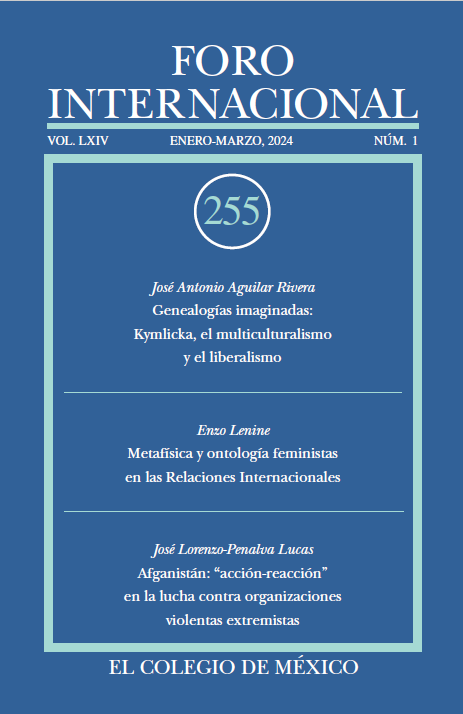Afghanistan: “action-reaction” in the fight against violent extremist organizations
DOI:
https://doi.org/10.24201/fi.v64i1.2980Keywords:
terrorism, extremism, conflict, security, defenceAbstract
This article studies the effects of government actions against insurgency and violent extremist organizations. It is argued that certain state policies and law enforcement actions can have counterproductive effects. Specifically, the “action-reaction” relationship between the surge of foreign troops in Afghanistan and the increase of the number of this force casualties as a result of adverse and counter-reaction in violent extremist jihadist organizations is explored. The findings corroborate and extend other research that suggests that, in certain modern asymmetric conflicts, the more military deployed on the ground, the higher the number of casualties that occur. The study suggests the need for decision-makers in conflicts to ask themselves about the optimal number of people on the ground and to choose courses of action that balance the stated objectives with the risk of troop casualties.
Downloads
References
ACKERMAN, G., “Understanding Terrorist Innovation Through the Broader Innovation Context” (Apéndice III, pp. 51-69), en M. Rasmussen y M. Hafez, Terrorist Innovations in Weapons of Mass Effect: Reconditions, Causes, and Predictive Indicators, informe de taller, Defense Threat Reduction Agency; Advanced Systems and Concepts Office, informe número ASCO 2010-2019, octubre de 2010, https://apps.dtic.mil/sti/pdfs/ADA556986.pdf
Afghanistan Index, “Tracking Progress and Security in Post-9/11 Afghanistan”, 25 de agosto de 2020 (último índice), https://www. brookings.edu/afghanistan-index/
ALLEN, Michael y Cynthia COLLEY, Will fear keep them in line? A formal model and empirical testing of the relationship between terrorism and repression. Comunicación presentada en el Annual meeting of the ISA’s 49th annual convention. San Francis- co, 26 de marzo de 2008.
“Ambassador Eikenberry’s Cables on U.S. Strategy in Afghanistan”, The New York Times, 9 de noviembre de 2009, https://www.nytimes.com/interactive/projects/documents/eikenberry-s-memos-on-the-strategy-in-afghanistan
American War and Military Operations. Casualties: Lists and Statistics, Congressional Research Service, RL32492, actualización de 29 de julio de 2020, https://crsreports.congress.gov/product/ pdf/RL/RL32492/33
ARREGUIN-TOFT, I., How the weak win wars: A theory of asymmetric conflict (vol. 99), Cambridge, Cambridge University Press, 2005. DOI: https://doi.org/10.1017/CBO9780511521645
AZNAR FERNÁNDEZ-MONTESINOS, Federico, La ecuación de la guerra, Barcelona, Editorial Montesinos, 2011.
BEAUFRE, André, Introducción a la Estrategia, Caracas, Rioplantense, 2002.
BELASCO, A., Troop Levels in the Afghan and Iraq Wars, FY2001-FY2012: Cost and Other Potential, Congressional Research Service, 2 de julio de 2009, https://sgp.fas.org/crs/natsec/R40682.pdf
BELASCO, A., The Cost of Iraq, Afghanistan, and Other Global War on Terror Operations Since 9/11, Congressional Research Service, 2 de septiembre de 2010, https://apps.dtic.mil/dtic/tr/fulltext/ u2/a528273.pdf
BELL, Sam R., David CINGRANELLI, Amanda MURDIE y Alper CAGLAYAN, “Coercion, capacity, and coordination: Predictors of political violence”, Conflict Management and Peace Science, 30(3), 2013, pp. 240-262, https://doi.org/10.1177/0738894213484032 DOI: https://doi.org/10.1177/0738894213484032
BRODIE, B. (ed.), The Absolute Weapon: Atomic Power and World Order, New Haven, Connecticut, Yale Institute of International Studies, 1946.
BROOKS, Risa, The best they could do? Assessing US military effectiveness in the Afghanistan War”, Armed Forces & Society, 49 (4), 2022, pp.913-922, https://doi.org/10.1177/0095327X221116876 DOI: https://doi.org/10.1177/0095327X221116876
CISNEROS, J. M. C., “Afganistán: dos décadas de conflicto”, Boletín IEED (BIE3), (18), 8 de junio de 2020, https://www.ieee.es/Galerias/fichero/docs_opinion/2020/DIEEEO84_2020JOSCAL_Afganistan.pdf
Consejo Europeo, European Union Counter Terrorism Strategy, 14469/4/05, Bruselas 30 de noviembre de 2005, https://data. consilium.europa.eu/doc/document/ST%2014469%20 2005%20REV%204/EN/pdf
CORDESMAN, Anthony H., “Afghanistan and Iraq: Learning the Lessons of Worst Case Wars”, Center for Strategic and International Studies (CSIS), https://www.csis.org/analysis/afghanistan-and-iraq-learning-lessons-worst-case-wars
CORNWELL, R., “From Now on This is Obama’s War”, The Independent, 5 de diciembre de 2009.
CRENSHAW, M., “The causes of terrorism”, Comparative Politics, 13 (4) 1981, pp. 379-399, http://courses.kvasaheim.com/hist319a/ docs/Crenshaw%201981.PDF DOI: https://doi.org/10.2307/421717
CRENSHAW, M., “Innovation: Decision points in the trajectory of terrorism” (apéndice ii, pp. 35-50), en M. Rasmussen y M. Hafez, Terrorist Innovations in Weapons of Mass Effect: Reconditions, Causes, and Predictive Indicators, informe de taller, Defense Threat Re- duction Agency; Advanced Systems and Concepts Office, informe número ASCO 2010-2019, octubre de 2010, https://apps. dtic.mil/sti/pdfs/ADA556986.pdf
DOLLARD, John, Neal MILLER, E. NEAL, L. DOOB, W. LEONARD, O.H. MOWRER y Robert R. SEARS, Frustration and Aggression, New Haven, Conn., Yale University Press, 1939, https://doi. org/10.1037/10022-000 DOI: https://doi.org/10.1037/10022-000
FERNÁNDEZ-MONTESINOS, Federico Aznar, La ecuación de la guerra, Barcelona, Editorial Montesinos, 2011.
Fund for Peace, Fragile States Index, Measuring Fragility Risk and Vulnerability in 179 Countries, 2020, https://fragilestatesindex. org/
GALTUNG, Johan, “A Structural Theory of Aggression”, Journal of Peace Research, 1 (2), 1964, 95-119, https://doi.org/10.1177/002234336400100203 DOI: https://doi.org/10.1177/002234336400100203
GALTUNG, Johan, The specific contribution of peace research to the study of the causes of violence: typologies, París, UNESCO, stc/75/coNF.5o8l9, 1975, https://www.transcend.org/galtung/papers.php
GATES, R. M., Exercise of Power: American Failures, Successes, and a New Path Forward in the Post-Cold War World, Nueva York, Knopf, 2020. Global Terrorism Index, Vision of Humanity, https://www.visionof-humanity.org/maps/global-terrorism-index/#/
Gobierno de Estados Unidos, Department of Army, FM6-0 Commander and Staff Organization and Operations, 2014, 224 pp., https://armypubs.army.mil/epubs/DR_pubs/DR_a/ ARN35404-FM_6-0-000-WEB-1.pdf
Gobierno de Estados Unidos, Departamento de Defensa, Enhancing Security and Stability in Afghanistan, 2019, https://media.defense. gov/2020/Jan/23/2002238296/-1/-1/1/1225-REPORT-DE- CEMBER-2019.PDF
Gobierno de Estados Unidos, Departamento de Defensa de Estados Unidos, Enhancing Security and Stability in Afghanistan, 2020, https://media.defense.gov/2021/Apr/23/2002626546/-1/- 1/0/ENHANCING-SECURITY-AND-STABILITY-IN-AFGHANI- STAN.PDF
Gobierno de Estados Unidos, Departamento de Defensa de Estados Unidos, Justification for FY 2020 Overseas Contingency Operations Afghanistan Security Forces Fund, 2019, https://comptroller.de- fense.gov/Portals/45/Documents/defbudget/fy2020/fy2020_ ASFF_Justification_Book.pdf
Gobierno de Estados Unidos, Departamento de Defensa de Estados Unidos, “Casualty Status as of 10 a.m. EST”, 21 de noviembre de 2023 (immediate release), https://www.defense.gov/casualty.pdf
GURR, Ted, Why Men Rebel, Princeton, New Jersey, Princeton University Press, 1970.
Institute for Economics and Peace, Global Terrorism Index, 2020, https://www.economicsandpeace.org/reports/
JENKINS, Brian Michael, Unconquerable Nation: Knowing Our Enemy, Strengthening ourselves, California, EE.UU., RAND Corporation, 2006, https://doi.org/10.7249/mg454 DOI: https://doi.org/10.7249/MG454
JOHNSON, R. B. y A. J. ONWUEGBUZIE, “The Validity Issue in Mixed Research”, Research in the Schools, vol. 13, núm. 1 (2006), pp. 48-63, http://lcwu.edu.pk/ocd/cfiles/Gender%20&%20Develop- ment%20Studies/GDS-502/Thevalidityissueinmixedresearch.pdf#page=55
KEEFER, P. y N. LOAYZA, Terrorism, economic development, and political openness, Cambridge, Cambridge University Press, 2008. DOI: https://doi.org/10.1017/CBO9780511754388
KING, A., “Why Did the Taliban Win?”, Armed Forces & Society, vol. 49 (4) (2023), pp. 923-938, https://doi.org/10.1177/ 0095327X221096702 DOI: https://doi.org/10.1177/0095327X221096702
KURZMAN, Charles y Assem HASNAIN, “When forecasts fail: Unpredictability in Israeli-Palestinian interaction”, Sociological Science, 1 (2014), pp. 239-259, https://doi.org/10.15195/v1.a16 DOI: https://doi.org/10.15195/v1.a16
LIDDELL HART, B. H., The decisive wars of history: a study in strategy, Sudáfrica, Bell, 1929.
LINKE, Andrew M., Frank D. W. WITMER y John O’LOUGHLIN, “Space-time granger analysis of the war in Iraq: A study of coalition and insurgent action-reaction”, International Interactions, 38(4), 2012, pp. 402-425, http://dx.doi.org/10.1080/03050629.2012.696996 DOI: https://doi.org/10.1080/03050629.2012.696996
LORENZO-PENALVA LUCAS, José, “Técnicas cuantitativas o cualitativas de utilidad en el análisis de inteligencia”, Comunicación pre- sentada en el Congreso Análisis de Inteligencia y Prospectiva de la Universidad de Granada, 2019, http://www.ugr.es/~gesi/congre- so/comunicacion29-3.pdf
LORENZO-PENALVA LUCAS, José, “Análisis de modelos matemáticos aplicados a la lucha contra el terrorismo y los extremismos violentos”, Revista Política y Estrategia, núm. 140 (2023), pp. 35-62, https://doi.org/10.26797/rpye.vi140.1008 DOI: https://doi.org/10.26797/rpye.vi140.1008
MALKASIAN, Carter, The American war in Afghanistan: A history, Oxford, Oxford University Press, 2021. DOI: https://doi.org/10.1093/oso/9780197550779.001.0001
McINNIS, Kathleen J. y Andrew FEICKERT, Additional Troops for Afghanistan? Considerations for Congress, Congressional Research Service, 19 de mayo de 2017, https://sgp.fas.org/crs/natsec/ R44853.pdf
MONTGOMERY, Brian C., Synchronic analysis of adversarial attacks in Syria committed by the Islamic State, Minneapolis, Walden University, Walden Dissertations and Doctoral Studies, 8631, 2020, https:// scholarworks.waldenu.edu/dissertations/8631
Naciones Unidas, Office of Counter-Terrorism, United Nations Global Counter-Terrorism Strategy, https://www.un.org/counterterror- ism/un-global-counter-terrorism-strategy
Naciones Unidas, Consejo de Seguridad (UNSCR), Resolution 1386 (2001), adoptada por el Consejo de Seguridad en su reunión 4443, del 20 de diciembre de 2001, http://unscr.com/en/resolutions/doc/1386
Naciones Unidas, “Afghanistan: Civilian casualties exceed 10,000 for sixth straight year”, UN News, 22 de febrero de 2020, https:// news.un.org/en/story/2020/02/1057921 (consulta del 12 de enero de 2023).
Naciones Unidas, United Nations Development Programme (UNDP), Human Development Index, Development and the Anthropocene, 2020, http://hdr.undp.org/en/2020-report/download
Organización del Tratado del Atlántico del Norte (OTAN), AJP-3.4.4 Ed A v.1 Allied Joint Doctrine for Counter-Insurgency (COIN), Bruselas, NATO Standardization Office, 2016, https://nso.nato.int/nso/nsdd/_CommonList.html?runQ=no
Organización del Tratado del Atlántico del Norte (OTAN), AJP-01 Ed E v.1 Allied Joint Doctrine, Bruselas, NATO Standardization Office, 2017, https://nso.nato.int/nso/nsdd/_CommonList.html?runQ=no
Organización del Tratado del Atlántico del Norte (OTAN), ISAF’s mission in Afghanistan (2001-2014), https://www.nato.int/
PIAZZA, James A., “Rooted in poverty? Terrorism, poor economic development and social cleavages”, Terrorism and Political Violence, 18, 2006, pp. 159-177, https://doi.org/10.1080/095465590944578 DOI: https://doi.org/10.1080/095465590944578
PIAZZA, James A., “Repression and Terrorism: A Cross-National Empirical Analysis of Types of Repression and Domestic Terrorism”, Terrorism and Political Violence, 29 (1), 2015, pp. 102-118, https://doi.org/10.1080/09546553.2014.994061 DOI: https://doi.org/10.1080/09546553.2014.994061
RASHID, A., Descent into chaos: The us and the disaster in Pakistan, Afghanistan and Central Asia, EE.UU., Penguin, 2008.
RAY, J., The Analogous Counterinsurgent: Afghanistan in Comparative Perspective, en APSA 2010 Annual Meeting Paper, https://papers.ssrn.com/Sol3/Delivery.cfm/SSRN_ID1670530_code1525289.pdf?abstractid=1657478
ROBISON, Kristopher, “Terror’s true nightmare? Reevaluating the consequences of terrorism on democratic governance”, Terror- ism and Political Violence, 22(1), 2010, pp. 62-86, https://doi. org/10.1080/09546550903409593 DOI: https://doi.org/10.1080/09546550903409593
SHELLING, Thomas C., The Strategy of Conflict, Cambridge, Mass., Harvard University Press, 1960, pp. 309.
SOPKO, J. F., What we need to learn: lessons from twenty years of Afghanistan reconstruction, Arlington, Virginia, 2021, https://www.sigar. mil/pdf/lessonslearned/SIGAR-21-46-LL.pdf
“The Mother of All Bombs: How badly did it hurt IS in Afghani- stan?”, BBC, 27 de abril de 2017, https://www.bbc.com/news/ world-asia-39705128 (consulta del 12 de enero de 2023).
TSE-TUNG, Mao, On protracted war. Selected Works of Mao Tse-tung, vol. II, Beijing, Foreign Languages Press, 1967 (1938).
TZU, Sun, El arte de la guerra, España, Editorial Librero, 2016.
WALSH, James y James PIAZZA, “Why respecting physical integrity rights reduces terrorism”, Comparative Political Studies, 43 (5), 2010, pp. 551-577, https://doi.org/10.1177/0010414009356176 DOI: https://doi.org/10.1177/0010414009356176
WIBERG, Håkan, Konflikt teori och fredsforskning, Estocolmo, Almqvistoch Wiksell, 1990 (1975).
WOODWARD, B., Obama’s Wars, Nueva York, Simon and Schuster, 2010.













